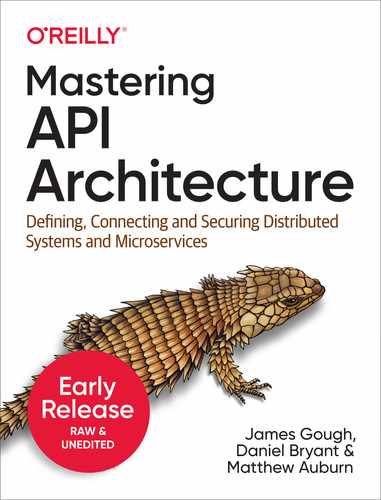Most organizations with a web presence build and operate APIs; the doorway for customers to interact with the company's services. Designing, building, and managing these critical programs affect everyone in the organization, from engineers and product owners to C-suite executives. But the real challenge for developers and solution architects is creating an API platform from the ground up. With this practical book, you'll learn strategies for building and testing REST APIs that use API gateways to combine offerings at the microservice level. Authors James Gough, Daniel Bryant, and Matthew Auburn demonstrate how simple additions to this infrastructure can help engineers and organizations migrate to the cloud; and open the opportunity to connect internal services using technologies like a service mesh.
Table of Contents
- 1. API Architecture Primer
- A Brief Introduction to APIs and Microservices Based Architecture
- Traffic Patterns: API Consumption From All Cardinal Points
- North-South Ingress Traffic
- East-West Service-to-Service Traffic
- Traffic Patterns and Traffic Management
- Different Types of API
- API Architecture Taxonomy
- Core Concepts
- The Open Systems Interconnection (OSI) Networking Model
- Control Planes and Data Planes
- Sidecar Pattern
- Evolving Architecture
- API Architecture Toolbox
- Architecture Decision Records (ADR)
- C4 Model
- Conference System Example
- Structurizr Tool
- Summary
- 2. Defining Rest APIs and Alternative API Approaches
- Introduction to REST
- The Richardson Maturity Model
- REST API Standards and Structure
- Collections and Pagination
- Filtering Collections
- Updating Data
- Error Handling
- Checklist: Choosing an API Standard
- Specifying REST APIs
- OpenAPI Specification Structure
- Visualizing OpenAPI Specifications
- Practical Application of OpenAPI Specifications
- Code Generation
- OpenAPI Validation
- Examples and Mocking
- Detecting Changes
- API Versioning
- Semantic Versioning
- API Lifecycle
- OpenAPI Specification and Versioning
- Alternative API Formats
- Remote Procedure Call (RPC)
- Implementing RPC with gRPC
- GraphQL
- Exchanges and Choosing an API Format
- High Traffic Services
- Large Exchange Payloads
- HTTP/2 Performance Benefits
- Vintage Formats
- Performance Testing Exchanges
- Checklist: Modelling Exchanges
- Multiple Specifications
- The Golden Specification
- Challenges of Combined Specifications
- Summary
- 3. Testing APIs
- Scenario for this chapter
- The Testing Quadrant
- The Testing Pyramid
- Unit Testing
- Test Driven Development
- Classicist and Mockist
- Service Testing
- Component tests
- Integration tests
- Introduction to Testcontainers
- Other dockerized services
- Service testing Summary
- UI Testing
- Subcutaneous Tests
- Behavior Driven Development
- UI test summary
- Testing during the building of your application
- Can you test too much?
- Summary
- 4. API Gateways
- What Is an API Gateway?
- What Functionality Does an API Gateway Provide?
- Where Is an API Gateway Deployed?
- How Does an API Gateway Integrate with a Typical Edge Stack?
- Why Use an API Gateway?
- Reduce Coupling: Adapter / Facade Between Front Ends and Back Ends
- Simplify Consumption: Aggregating / Translating Back End Services
- Protect APIs from Overuse and Abuse: Threat Detection and Mitigation
- Understand How APIs Are Being Consumed: Observability
- Manage APIs as Products: API Lifecycle Management
- Monetize APIs: Account Management, Billing, and Payment
- A Modern History of API Gateways
- Late 1990s: Hardware Load Balancers
- Early 2000s: Software Load Balancers
- Mid 2000s: Application Delivery Controllers
- Early 2010s: First Generation API Gateways
- 2015 Onwards: Second Generation API Gateways
- Coda (2017 Onwards): Service Mesh and/or API Gateway?
- Current API Gateway Taxonomy
- Traditional Enterprise Gateways
- Micro/Microservices Gateways
- Service Mesh Gateways
- Comparing API Gateway Types
- Deploying API Gateways: Understanding and Managing Failure
- API Gateway as a Single Point of Failure
- Detecting Problems
- Resolving Incidents and Issues
- Mitigating Risks
- API Gateway Antipatterns: Mixing Traffic Patterns
- API Gateway Loopback: “Service Mesh Lite”
- API Gateway as an ESB: Egregious Spaghetti Boxes?
- Turtles (API Gateways) All the Way Down
- Selecting an API Gateway
- Identifying Requirements
- Exploring Constraints: Team, Technologies, and Roadmap
- Build Versus Buy
- Radars, Quadrants, and Trend Reports
- API Gateway: A Type 1 Decision
- Checklist: Selecting an API Gateway
- Summary
